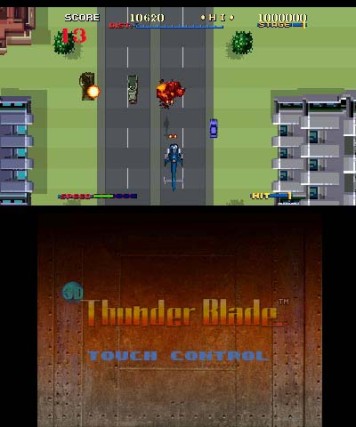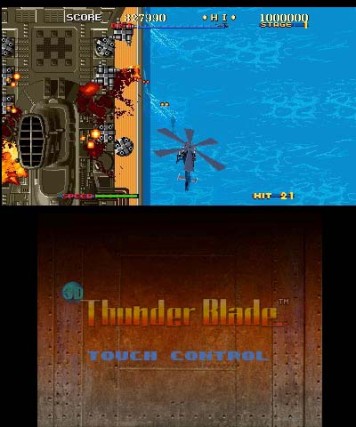Out Run. After Burner. Space Harrier. Thunder Blade. So, which one is the odd one out? For 99% of gamers, it will inevitably be the latter. While a very solid 80s arcade shooter in its own right, Thunder Blade never captured the public imagination in quite the same way as many of Yu Suzuki’s most memorable arcade classics – of course, it never helped that the home ports were rarely up to much either. While each of the aforementioned arcade hits had their own struggles with home console ports, Thunder Blade was certainly worse served than most with the Mega Drive and, in particular, the unsurprisingly shocking Master System ports falling painfully short of the exceptionally high technical standards set by the arcade original.
In retrospect, it’s clear that Thunder Blade isn’t in quite the same league as the Out Run’s and After Burner’s of this world, but this fantastic 3DS port does at least give gamers a chance to experience it the way it always should have been. Yes, there is no substitute for an all singing, all dancing arcade cabinet, but M2 have once again gone above and beyond to deliver an experience as close as is humanly possible. Like all of their fantastic 3D Sega ports, Thunder Blade comes with plenty of new content, fantastic 3D visuals, an optional simulated cabinet view, and above all else, a perfect recreation of the original’s visuals and gameplay. It may have been released way back in 1987, but Thunder Blade is still a looker, and thanks to the brilliant implementation of the console’s 3D capabilities, arguably looks better than ever before.
Yes, Thunder Blade was never the best arcade game of all time, and the slightly iffy collision detection and extremely short running time both remain major issues, but even with these problems, Thunder Blade remains a highly playable, highly enjoyable arcade shooter that offers up a surprising degree of variety across its very ultimately limited selection of stages – it might only have four stages, but each one is essentially split into three parts, each offering a unique style of gameplay.
All four stages begin like a traditional top down vertical shooter with the added ability of being able to move in three dimensions. It doesn’t add a great deal to the traditional vertical scrolling shooter gameplay, but it’s noteable for being one of the very few games of this ilk that allow for movement on the additional axis. If nothing else, it certainly looks very cool and makes great use of the handheld’s 3D capabilities. These sections are rarely difficult, but they are nothing if not fun and essentially feel like a completely different game to the second section of each stage that sees you flying into the screen ala Space Harrier.
Probably the type of gameplay that most people think of when they think of Thunder Blade, these sections are more challenging and unquestionably more frustrating. Hit detection is all over the place while the ability to slow down and speed up is likely to get you little other than dead. Like Space Harrier and After Burner before it, these sections aren’t the most accurate and are far from the technical marvels that they were back in the 80s (the top down sections arguably hold up better), but even with these issues, there is something to be said for hurtling toward the screen in full 60 fps as you dodge enemy aircraft and often inexplicably placed pieces of scenery. It’s never as accurate or as tight as many of today’s shooters, but then, that’s not the point. These are quick-fire, high adrenaline experiences, and in a time of overtly bloated video games, I for one welcome the return of such classic arcade fodder.
Each stage subsequently ends with a return to the top-down, vertically scrolling view for a boss battles that, while always visually impressive, deliver next to no actual challenge. Other than the final boss, these encounters merely require survival and are little more than glorified bombing runs. It’s a shame, as these sections could, and really should, have provided an exciting finale to each stage, but instead, they play out as forgone conclusions as you blindly swerve back and forth to avoid the limited gunfire headed your way. Like everything else in the game, these sections look great, but unless you’re chasing a particular high score, they can play out in painfully underwhelming fashion.
Despite its short length, M2 have once again done an admirable job of extending the experience without creating unwanted padding. An extra stage section and additional final boss battle are both welcome additions while some tweaks to enemy placement and scoring deliver something a bit different for long-time fans. As always though, it’s the little touches that make all the difference – the gyro controls, the multitude of different views, the fantastic sound, whether you like the game or not, there is no arguing with the quality of M2’s work. Like all of their recent Sega arcade ports, this is yet another sprite scaling classic and proof positive that Sega used to be a company at the very forefront of exceptional (and always exciting) video game design.
REVIEW CODE: A complimentary Nintendo 3DS code was provided to Bonus Stage for this review. Please send all review code enquiries to press@4gn.co.uk.
Subscribe to our mailing list
Get the latest game reviews, news, features, and more straight to your inbox
Thank you for subscribing to Bonus Stage.
Something went wrong.
-
Gameplay - /10
0/10
-
Graphics - /10
0/10
-
Sound - /10
0/10
-
Replay Value - /10
0/10









